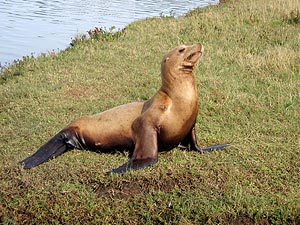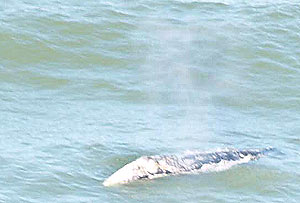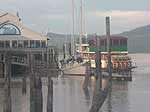 |
Published 09/12/09
Oregon Coast Coughs Up Kooky Critters
 |
| Two injured comorants waiting for rescue at the Seaside Aquarium (photo Tiffany Boothe, Seaside Aquarium). |
(Oregon Coast) – It's typically the warmest time of the year on the coast, and that is causing all kinds of marine creatures to show themselves in some unusual ways. From whales, weird phytoplankton to sea lions popping up places they shouldn't, to funky bugs and interesting birds – there's something to see just about everywhere on the coast.
But there’s a serious note to all this, as there is still a continued rash of birds getting killed by cars on the beach.
On the north coast, Seaside Aquarium’s Tiffany Boothe said wildlife has been causing a stir there.
While seals make up the larger portion of stuff seen on the beaches, sea lions have been making startling appearances. Three juvenile California sea lions have come ashore in high profile locations. One particular sea lion has been roaming around the Necanicum and Neawanna rivers for the past few days.
“He’s been spotted near the outlet mall, estuary, Ave. S and is currently resting at Quatat Park,” Boothe said. “He has been traveling up and down both rivers daily.”
 |
| A young sea lion visits the river at Seaside (photo Seaside Aquarium) |
Whales have been unusually visible in Seaside this summer, and they’re still popping up.
“And the whales just keep on coming,” Boothe said. “Gray whales are still being spotted daily in the cove, in front of the aquarium, and out near Sunset Beach.”
Boothe said landlubbers can sometimes see them from their homes on the aquarium’s web cam: www.seasideaquarium.com.
Birds injured by automobiles driving on the beaches began being problematic earlier this summer, and that has been maintained in record, alarming numbers. Boothe said the Wildlife Center of the North Coast (www.coastwildlife.org) has been bombarded with injured birds.
 |
| A sea lion lounges at Quatat Park (photo Seaside Aquarium). |
Director Sharnelle Fee has been prominent in the news media recently talking about these deaths. She said she believes the dead and injured birds being seen are only a small portion of what’s really getting killed on the sands of the north coast. Most bodies of birds probably wash away with the tide.
"The aquarium has been receiving multiple injured birds each day," Boothe said. "In one day we had a pelican, two cormorants, a common murre, and two sea gulls waiting here for Sharnelle."
Shorebirds are protected by law, and killing them or hurting them is a misdemeanor crime under the federal Migratory Bird Treaty Act of 1918. It is punishable by as much as six months in jail and a $15,000 fine.
 |
| Whales at the cove in Seaside (photo Seaside Aquarium) |
Authorities are offering rewards of up to $1,000 for information leading to the arrest of those committing these crimes.
On the north coast, lots of brown waves are hitting the beaches. They’ve been seen in sporadic spots around Manzanita, Cannon Beach and Seaside. These are caused by lots of phytoplankton in the ocean. They often leave large brown spots or big patches of brown bubbles and foam at the tide line.
Often, these are more prominent in the Seaside area and taint all the incoming waves that color. This time, they’ve done something curious by showing up in small areas on these beaches, as if currents were pushing them inward in selective areas only.
 |
| Whales at the cove in Seaside (photo Seaside Aquarium) |
Brown waves or goo are often mistaken for some kind of pollution event. It is, in fact, the sign of a very healthy ocean.
On the central coast, dragonflies are the stuff of major sightings. Newport resident Range Bayer has been collecting the reports of masses of them zipping along the areas between Newport and Neskowin.
Bayer said resident Bob Olson reported seeing 15 dragonflies flying south by southeast around the Hatfield Marine Science Center (HMSC) Nature Trail on September 9. He also reported spotting two Hudsonian Godwits – a rather spectacular bird – on that afternoon.
On September 10, Bayer said hundreds of them were spotted on Cascade Head, just north of Lincoln City. They were the Variegated Meadowhawks (Sympetrum corruptum), a species of dragonfly that greatly predominate in directed flights ("migration") in one direction.
 |
| A Variegated Meadowhawk dragonfly - photo Terry Morse. |
Coastal resident Phil Pickering reported to Bayer the hundreds of them were "flushing from the grass everywhere – no directional movement."
This time of year will lead to more sightings, Bayer said.
“We are still in the time window in September and early October when directed dragonfly flights may still occur along the Oregon coast,” Bayer said. Mid-September can be particularly good in some years.”
Elements of the “second summer” on the coast – the time of year when the region is at its warmest – contribute to these nifty nuggets of nature. East winds are often predominate this time of year along the beaches.
“These flights occur generally when there are strong winds from the east, and it is very warm,” Bayer said.
Given the exceptionally warm conditions happening about now, Bayer predicted there could be some “major flights” of the wildly colored creatures.
 |
| Cascade Head |
“These dragonflies are not flying in a dense cloud but are generally spread out and can easily be missed,” Bayer said. “A major flight usually only lasts a few hours and is rarely more than 1.5 miles inland from the coast. They have often been seen at the HMSC.”
Many dragonflies can be present and milling around in an area that’s favorable for dragonflies. But in a directional flight, the vast majority are flying in one direction, usually south during the flight, but changing to southeast or even east at the end of a flight.
Additional information about these flights is at: http://www.ent.orst.edu/ore_dfly/migrate.htm
 |
RELATED STORIES
Unusual Travel Articles TravelParanormal.com allows you to submit your own creepy tale or debunk one - or see up-to-the-minute news headlines about travel and the paranormal.
Watching Transformations of Oregon Coast Beaches Seasons change and so do beaches, revealing different sides and a variety of eye-popping sights
Staggeringly Cool Ideas for Oregon Coast Romance Be it the season of Valentine's or be it any time of the year, Oregon's coastline has essentially cornered the market for cuddle-inducing possibilities and gushy activities for the hand-holding set
Day or Night Mysteries and Merriment on Oregon Coast It's more than just nightlife that comes to life, but the beaches offer major opportunities
News Headlines from All Over Oregon Need to scan Oregon headlines? Constantly updated news from all over Oregon: a comprehensive, up-to-the-minute display of news headlines from a variety of media.
Oregon
Coast Lodging
|
|||||||||||||
OR
TAKE THE VIRTUAL TOUR |
|||||||||||||
|
Secrets of the Season |







































